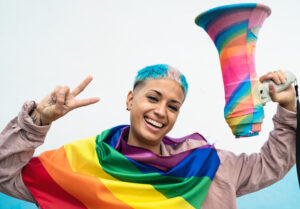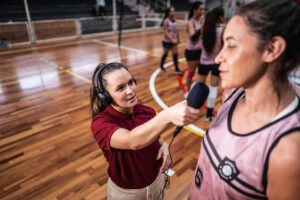Communicators can help promote LGBTQ+ equality in and out of work. Here’s how.
From ourselves to our communities, communicators can lead change.

Young woman celebrating gay pride event wearing rainbow flag symbol of Lgbt social movement
Whether you’re an in-house PR pro or work for an agency, whether you’re working for a Fortune 100 company or a governmental agency, you’re almost certain to handle topics of deep importance to the LGBTQ+ community — and not just during Pride month.
If you yourself are a member of that community, that work is doubly personal, a charge to be your authentic self while navigating waters that are often still treacherous.
As part of The Museum of PR’s recent “LGBTQ Rights On the Line: The Role of Communicators Advocating for Equality” event, five LGBTQ+ communications pros came together to discuss what the communications industry owes to the cause of equality — and to each other.
The responses highlighted the challenges and opportunities that communicators, especially those in the queer community, have in creating a more just world for people of all identities and orientations.
Understanding intersectionality
The diverse panel talked at length about the need for intersectionality — or recognizing where the interests of multiple marginalized and underrepresented groups meet — in communications about LGBTQ+ topics.
“The gay movement can often feel very white and mainstream … I think we should be honest about that. And it often feels like AAPI, folks, black folks and Latino folks are often left out,” said Jared DeWese, deputy director for communications for climate and energy for Third Way. DeWese said his visible identity as a Black man intersects with his invisible identity as a gay man.
Cathy Renna, communications director of the National LGBTQ Task Force, agreed. “Our community is a microcosm of the larger culture,” she said. “Our sexual orientation or gender identity have nothing to do with our age, or race or economic status, or ethnicity, all of those things.”
It’s because of those intersections that it’s so critical for communicators to help others understand how various topics affect these groups separately and as an interconnected identity. For Renna, that means helping explain how topics like Roe v. Wade will have deep impacts on various facets of the LGBTQ+ community, from possible implications on marriage equality to queer and trans people who need access to birth control and contraception, as well as the broader topic of bodily autonomy.
Shin Inouye, executive vice president of communications at The Leadership Conference on Civil and Human Rights and The Leadership Conference Education Fund, said that this need for education also manifests as communicators provide resources for employees in the wake of intersectional tragedies like the Buffalo shooting.
Educating internal and external audiences
Education is almost always one of the key roles of the communicator. This is even more important when dealing with topics relevant to a group that is as often misunderstood or outright vilified as the LGBTQ+ community.
Rich Ferraro, chief communications officer for GLAAD, cited the need to have communicators in all aspects of PR, from corporate to agency, who are ready to tell those stories using the power of those institutions. He cited the Edelman Trust Barometer, which for the third year in a row found that brands and companies are more trusted than any other institution.
“We as PR professionals, especially you who are working at big brands, have the power via social media, via public statement, via internal communications, to start telling the truth and start sharing the stories that move the needle on equality. It can change hearts and minds,” Ferraro said.
Renna said that after appearing on conservative commentator Bill O’Reilly’s show, she would get emails from people who told her they’d never thought about a topic in a certain way until they heard her.
“See, this is why I go on the Bill O’Reilly show, not because I feel like I’m going to change his mind, Lord knows,” Renna said, “but because you have to help people start that journey.”
Ferraro also noted the importance of education in traditional media relations, including his role at GLAAD.
“It’s up to us to make sure that the biggest media outlets or the local media outlets —which, sometimes that’s even more important — are telling our stories fairly accurately and reporting on some of these gross [anti-LGBTQ+] bills properly, because the other the other side is trying to use clever talking points and really manipulate the stories,” he said.
Be authentic
The word “authentic” is used so frequently by communicators and in so many ways, it can be difficult to find true meaning in it. But it was clear that the term holds special meaning for these LGBTQ+ communicators as a way of being true to yourself and the journey you’re on.
“I can’t imagine doing work in the communications field without it being from an authentic place,” said Tracy Balm, president and co-publisher of the Chicago Reader and co-founder of Windy City Times. “How are we telling other people’s stories if we’re hiding something in ourselves?”
Balm spoke passionately about the need to be open about your identity, a privilege that not all queer communicators who came before had.
“We have one life to live I would say to people, and don’t start your career in the closet. Don’t continue your career in the closet, don’t end your career in the closet,” she said. “If you can, at all, possibly, do it safely. Be out — starting today. We have one life. And I have no regrets that I took this gay path.”







